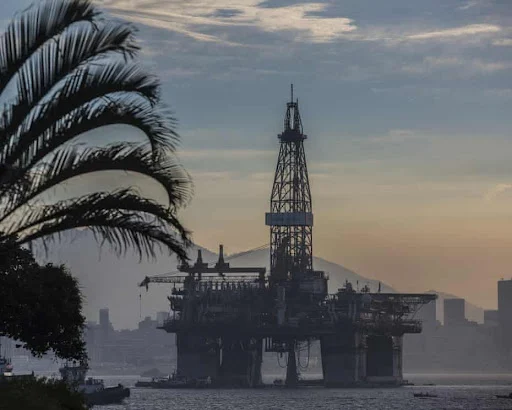🌍 “Brazil’s Equatorial Margin: The New Oil Frontier from Amapá to Rio Grande do Norte”
🚢 1. Opening New Energy Boundaries

The Equatorial Margin—spanning Brazil’s northern coast from Amapá to Rio Grande do Norte—is emerging as the country’s next energy frontier. Comprising five offshore sedimentary basins—Foz do Amazonas (also called Amapá Deep Water), Pará–Maranhão, Barreirinhas, Ceará, and Potiguar—this region mirrors the geology of Guyana and Suriname, where over 13 billion barrels of oil have been discovered. Recent estimates suggest the Brazilian Equatorial Margin holds up to 30 billion barrels of oil in place.
🛢️ 2. Strategic Oil Licensing & Major Players
In June 2025, Brazil’s National Petroleum Agency (ANP) conducted its 5th permanent concession round. Petrobras, ExxonMobil, Chevron, BP, Shell, Petronas, Equinor, CNPC, and others secured blocks across the Equatorial Margin—including five in Foz do Amazonas by a Petrobras‑Exxon consortium and nine by Chevron‑CNPC . This round included 47 blocks in deep and ultra-deep waters, signaling renewed international interest.
🏛️ 3. Regulatory Hurdles & Environmental Review
Approval from IBAMA (Brazil’s environmental agency) remains a critical bottleneck. In May 2025, IBAMA approved Petrobras’s oiled‑fauna protection plan—a key step toward exploratory drilling—but mandated a broader, multi-year environmental study (AAAS) for further licensing. The agency chief emphasized that without this comprehensive assessment, fragmented licensing would be unlikely . Previously, in May 2023, Ibama had rejected Petrobras’s license for Block FZA‑M‑59 due to spill‑response concerns.
🤝 4. Federal Support & Economic Rationale
Brazil’s leadership publicly supports research into these reserves. In May 2025, Finance Minister Fernando Haddad backed exploration, calling for a balance between drilling and the nation’s energy transition . President Lula also endorsed drilling near the Amazon estuary, with a position that oil revenues can finance renewable energy efforts—despite criticism that it may undermine Brazil’s climate leadership ahead of COP30.
(Brazil to auction oil exploration rights months before hosting Cop30)
⚙️ 5. Investment Outlook & Geological Promise
Petrobras has committed approximately US$3 billion to Equatorial Margin exploratory drilling through 2029, including plans for around 15 wells . The broader oil investment by 2029 is projected at US$7.9 billion—about 38% slated for these basins. Geological data from TGS highlights this region’s similarity to Guyana/Suriname margins, boosting optimism for yields.
🌬️ 6. Wind Power and Hydrogen Synergy
Beyond oil and gas, the Equatorial Margin shows considerable potential in offshore wind and green hydrogen. Brazil’s SENAI‑ISI‑ER network has installed the country’s largest offshore wind resource LiDAR array from Rio Grande do Norte to Amapá. This network supports prospective wind farms and green hydrogen start-ups . Offshore wind farm projects await IBAMA approval—yet resource mapping data is being collected through at least November 2025 in line with COP30.
🌱 7. Balancing Growth & Environmental Stewardship
The Equatorial Margin’s development has sparked a national debate: should Brazil emphasize energy resource sovereignty or protect its tropical marine ecosystems? Advocates point to new jobs, regional royalties, and diversification away from Southeast‑concentrated production . Critics warn that licensing drilling before completing environmental assessments and Indigenous consultations could undermine climate commitments.
⚖️ 8. Global Context & COP30 Implications
With COP30 scheduled for November 2025 in Belém, Brazil walks a precarious path: simultaneously promoting fossil fuel exploration and climate leadership. Environmental campaigners call the June auction “doomsday”—citing potential emissions of over 11 billion tonnes CO₂ equivalent . Lula and Haddad argue that oil revenue will underpin renewable investments—but to maintain credibility, Brazil must align exploration with thorough environmental review.
🔍 Final Take: Brazil’s Energy Balance
Brazil’s Equatorial Margin is beckoning as both a strategic energy frontier and an ecological pivot. The next few years—including licensing decisions, emission studies, and COP30 outcomes—will determine if this multi‑resource offshore region becomes a coherent chapter in Brazil’s sustainable growth. With $10‑30 billion barrels in oil in place, deep‑water wells underway, burgeoning wind‑to‑hydrogen initiatives, and rigorous environmental oversight, this region may define Brazil’s role in the 21st‑century energy landscape.




Comments
Post a Comment